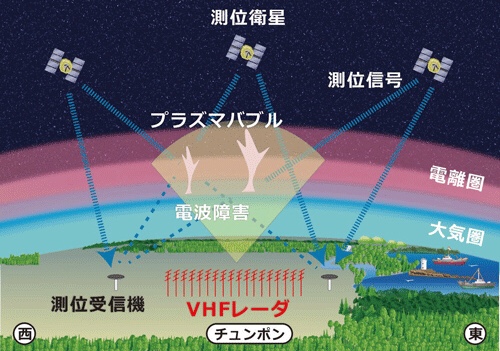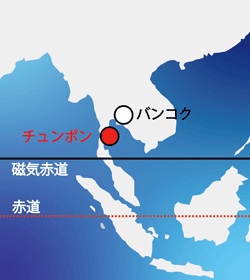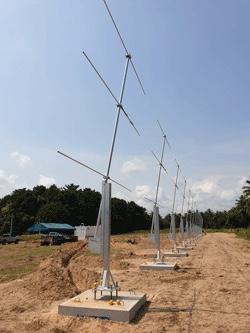


NICT:プラズマバブル観測レーダを設置:タイ/チュンポン・KMITL(動画):
NICT: Installed Plasma Bubble Observation Radar: Thailand / Chumphon, KMITL:
NICT:已安装的等离子气泡观测雷达:泰国/春蓬,KMITL
NICT:国際民間航空機関(ICAO)
2019年11月7日(木)、国際民間航空機関(ICAO)が、グローバル宇宙天気情報の提供サービスを開始しました。
NICTは、当該センターの一員として、通信、衛星測位、放射線被ばくに関する情報を提供しています。
既に、NICTは、1988年から「宇宙天気予報」を毎日配信していました。
電離圏の乱れ:プラズマバブルが原因
「電離圏の乱れに由来する衛星測位の誤差の増加」が問題になっています。
電離圏の乱れの原因は、地球磁場の赤道(磁気赤道)を中心に発生する「プラズマバブル」です。
プラズマバブルの付近では、「プラズマバブル」により、衛星測位精度が低下します。
プラズマバブル観測レーダ:(図1参照)
プラズマバブルは、低緯度のみならず、中緯度に位置する日本などでも、測位誤差を引き起こします。
プラズマバブルの継続的な観測や発生の予測を行うことが、近年強く望まれてきました。
今回、NICTはKMITLと共同で、プラズマバブル観測のためのレーダをKMITLチュンポンキャンパスに設置。
2020年1月17日(金)から運用を開始します。
タイ/チュンポン:(図2参照)
チュンポンは、磁気赤道に近く、その発生直後の状況をいち早くとらえることができます。
プラズマバブルを観測するレーダの設置をするには最適な場所です。
プラズマバブル観測レーダ:機能仕様(図3参照)
- このレーダは、東西90 mの敷地内に等間隔に設置
- 18本のアンテナから成るレーダシステム。
- VHF帯(39.65 MHz)の電波を利用。
レーダから発射された電波は、電離圏のプラズマバブルが作り出す不規則な形状によって反射されます。
戻ってくる電波を観測することで、プラズマバブルの位置や速度を把握することができます。
本レーダの設置によって、プラズマバブルの定常的な観測が可能となりました。
人工衛星利用した高精度測位の、東南アジア域/農業・建築分野での利用拡大に貢献します。
NICT-情報通信研究機構